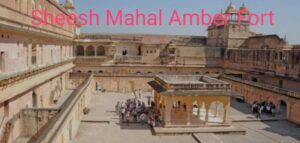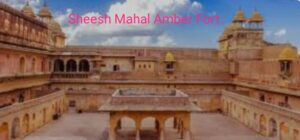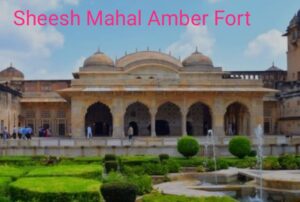Nestled within the grandeur of Sheesh Mahal Amber Fort in Jaipur, Rajasthan, Sheesh Mahal, or the “Mirror Palace,” stands as a testament to the opulence and artistic prowess of the Rajput era. This architectural marvel is renowned for its intricate mirror work, which has fascinated visitors for centuries. In this blog post, we will explore the rich history, stunning architecture, and cultural significance of Sheesh Mahal, making it a must-visit destination for history enthusiasts and tourists alike.

1.History of Sheesh Mahal Amber Fort
Constructed in the 16th century, Sheesh Mahal was built under the patronage of Maharaja Man Singh, one of the most prominent rulers of Amber. The palace was designed by master architects and craftsmen who aimed to create a space that epitomized luxury and splendor. The primary purpose of Sheesh Mahal was to serve as a royal chamber where the king and his queens could enjoy a serene and opulent environment.
The mirror palace played a significant role in royal ceremonies and gatherings, often serving as the backdrop for grand feasts and celebrations. The exquisite design and intricate craftsmanship made it a symbol of the wealth and power of the Rajput rulers.
2. Sheesh Mahal Amber Fort: Architectural Marvels
One of the most captivating features of Sheesh Mahal is its elaborate mirror work, known as “Kanch ki Barfi.” Thousands of small, intricately cut mirrors adorn the walls and ceilings, reflecting light in a dazzling array of patterns. These mirrors were imported from Belgium and were carefully arranged to create a stunning visual effect.
The walls of Sheesh Mahal are also adorned with intricate floral patterns and motifs, crafted using a combination of precious stones, glass, and semi-precious materials. The craftsmanship involved in creating these designs is a testament to the skill and dedication of the artisans of that era. The use of reflective surfaces and the play of light give the palace an ethereal quality, making it appear as though the entire structure is shimmering with a thousand tiny stars.

3.Sheesh Mahal Amber Fort: Artistic Elements
Sheesh Mahal is a perfect blend of Mughal and Rajput architectural styles. The frescoes and paintings that adorn the walls depict scenes from Hindu mythology and royal life. The intricate floral patterns and geometric designs are influenced by Persian art, which was prevalent during the Mughal era.
The use of vibrant colors and delicate brushwork adds to the overall aesthetic appeal of the palace. Each element of the design has a symbolic meaning, often representing prosperity, beauty, and the divine. The combination of these artistic elements creates a visually stunning and culturally rich environment that transports visitors to a bygone era of grandeur and elegance.
4.Sheesh Mahal Amber Fort: Cultural Significance
Sheesh Mahal holds immense cultural significance in the context of Rajput heritage. It is a symbol of the artistic and architectural achievements of the Rajput rulers and serves as a reminder of their rich cultural legacy. The palace has been the subject of numerous stories and legends, adding to its allure and mystique.
Comparisons are often drawn between Sheesh Mahal and other mirror palaces in India, such as the Sheesh Mahal in the Red Fort of Agra. However, the unique blend of Rajput and Mughal styles in the Amber Fort’s Sheesh Mahal sets it apart as a truly distinctive and remarkable structure.
5.Amber Fort: Tourism and Accessibility
Today, Sheesh Mahal is a major tourist attraction, drawing visitors from around the world who come to marvel at its beauty and historical significance. The palace is well-preserved, thanks to ongoing conservation efforts by the Archaeological Survey of India and other heritage organizations.
Visitors can explore the palace as part of a guided tour of Amber Fort, which offers a comprehensive overview of the fort’s history and architecture. The best time to visit is during the cooler months, from October to March, when the weather is pleasant and conducive to sightseeing. Photography enthusiasts will find ample opportunities to capture the stunning interplay of light and mirrors within the palace.

6. Sheesh Mahal in Popular Culture
Sheesh Mahal has been featured in various films, television shows, and documentaries, further cementing its status as an iconic symbol of Indian heritage. Its breathtaking interiors have served as a backdrop for numerous Bollywood films, including the popular song “Jab Pyar Kiya To Darna Kya” from the classic movie “Mughal-e-Azam.”
The palace’s influence extends beyond cinema, inspiring contemporary artists and architects who seek to recreate its intricate designs and opulent ambiance in modern settings. Additionally, Sheesh Mahal hosts cultural events and performances, offering visitors a chance to experience the vibrant traditions of Rajasthan.
Conclusion:
Sheesh Mahal at Amber Fort is more than just a historical monument; it is a living testament to the artistic and architectural brilliance of the Rajput era. Its dazzling mirror work, intricate designs, and cultural significance make it a must-visit destination for anyone interested in India’s rich heritage. As we continue to preserve and celebrate such treasures, we ensure that future generations can experience and appreciate the grandeur of Sheesh Mahal, a true jewel in the crown of Amber Fort.
FAQ:
1.Is Sheesh Mahal inside Amer Fort?
2.What is special about Sheesh Mahal?
3.What is the history of Sheesh Mahal in Jaipur?
4.Sheesh mahal amber fort price
5.Jal Mahal to Sheesh Mahal distance
6.Sheesh Mahal Jaipur photos
7.Sheesh Mahal Amber Fort reviews
8.Sheesh Mahal Jaipur
9.Sheesh Mahal Jaipur dinner price


Pingback: Daulatabad Fort Aurangabad : The Best Architectural Marvel Through the Ages - solotraveler